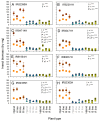Heterosis for Interactions between Insect Herbivores and 3-Line Hybrid Rice under Low and High Soil Nitrogen Conditions
- PMID: 38921131
- PMCID: PMC11204250
- DOI: 10.3390/insects15060416
Heterosis for Interactions between Insect Herbivores and 3-Line Hybrid Rice under Low and High Soil Nitrogen Conditions
Abstract
Hybrid rice results from crossing a male-sterile line (the A line) with a pollen doner (the restorer or R line). In 3-line hybrid breeding systems, a fertile B line is also required to maintain A line populations. Heterosis is defined as a condition of traits whereby the hybrid exceeds the average of the parental lines. Heterobeltiosis is where the hybrid exceeds both parents. Hybrid rice may display heterosis/heterobeltiosis for growth, yield and resistance to herbivores, among other traits. In a greenhouse experiment, we assessed the frequency of heterosis for resistance to the brown planthopper (Nilaparvata lugans (BPH)), whitebacked planthopper (Sogatella furcifera (WBPH)) and yellow stemborer (Scirpophaga incertulas (YSB)) in eight hybrids under varying soil nitrogen conditions. We also assessed plant biomass losses due to herbivore feeding as an approximation of tolerance (the plant's capacity to compensate for damage). Nitrogen reduced resistance to all three herbivores but was also associated with tolerance to WBPH and YSB based on improved plant survival, growth and/or yields. Plant biomass losses per unit weight of WBPH also declined under high nitrogen conditions for a number of hybrids, and there were several cases of overcompensation in rice for attacks by this herbivore. There was one case of nitrogen-related tolerance to BPH (increased grain yield) for a hybrid line with relatively high resistance, likely due to quantitative traits. Heterosis and heterobeltiosis were not essential to produce relatively high herbivore resistance or tolerance across hybrids.
Keywords: brown planthopper; fertilizer; herbivory tolerance; heterobeltiosis; heterosis; host plant resistance; plant physiology; rice herbivores; whitebacked planthopper; yellow stemborer.
Conflict of interest statement
The authors declare no conflicts of interest.
Figures




Similar articles
-
Origins of Susceptibility to Insect Herbivores in High-Yielding Hybrid and Inbred Rice Genotypes.Insects. 2024 Aug 12;15(8):608. doi: 10.3390/insects15080608. Insects. 2024. PMID: 39194813 Free PMC article.
-
Heterosis for Resistance to Insect Herbivores in a 3-Line Hybrid Rice System.Insects. 2024 Feb 28;15(3):164. doi: 10.3390/insects15030164. Insects. 2024. PMID: 38535360 Free PMC article.
-
Resistance and tolerance to the brown planthopper, Nilaparvata lugens (Stål), in rice infested at different growth stages across a gradient of nitrogen applications.Field Crops Res. 2018 Mar;217:53-65. doi: 10.1016/j.fcr.2017.12.008. Field Crops Res. 2018. PMID: 29503500 Free PMC article.
-
Understanding the genetic and molecular constitutions of heterosis for developing hybrid rice.J Genet Genomics. 2022 May;49(5):385-393. doi: 10.1016/j.jgg.2022.02.022. Epub 2022 Mar 8. J Genet Genomics. 2022. PMID: 35276387 Review.
-
Southern rice black-streaked dwarf virus: a white-backed planthopper-transmitted fijivirus threatening rice production in Asia.Front Microbiol. 2013 Sep 9;4:270. doi: 10.3389/fmicb.2013.00270. Front Microbiol. 2013. PMID: 24058362 Free PMC article. Review.
Cited by
-
Virulence Adaptation by Rice Planthoppers and Leafhoppers to Resistance Genes and Loci: A Review.Insects. 2024 Aug 29;15(9):652. doi: 10.3390/insects15090652. Insects. 2024. PMID: 39336620 Free PMC article. Review.
-
Origins of Susceptibility to Insect Herbivores in High-Yielding Hybrid and Inbred Rice Genotypes.Insects. 2024 Aug 12;15(8):608. doi: 10.3390/insects15080608. Insects. 2024. PMID: 39194813 Free PMC article.
References
-
- Horgan F.G., Crisol E. Hybrid rice and insect herbivores in Asia. Entomol. Exp. Appl. 2013;148:1–19. doi: 10.1111/eea.12080. - DOI
-
- Cheng S.H., Cao L.Y., Zhuang J.Y., Chen S.G., Zhan X.D., Fan Y.Y., Zhu D.F., Min S.K. Super hybrid rice breeding in China: Achievements and prospects. J. Integr. Plant Biol. 2007;49:805–810. doi: 10.1111/j.1744-7909.2007.00514.x. - DOI
-
- Spielman D.J., Kolady D.E., Ward P.S. The prospects for hybrid rice in India. Food Secur. 2013;5:651–665. doi: 10.1007/s12571-013-0291-7. - DOI
-
- Virmani S. Prospects of hybrid rice in the tropics and subtropics. In: Virmani S.S., editor. Hybrid Rice Technology: New Developments and Future Prospects. International Rice Research Institute; Los Baños, Philippines: 1994. pp. 7–19.
Grants and funding
LinkOut - more resources
Full Text Sources

